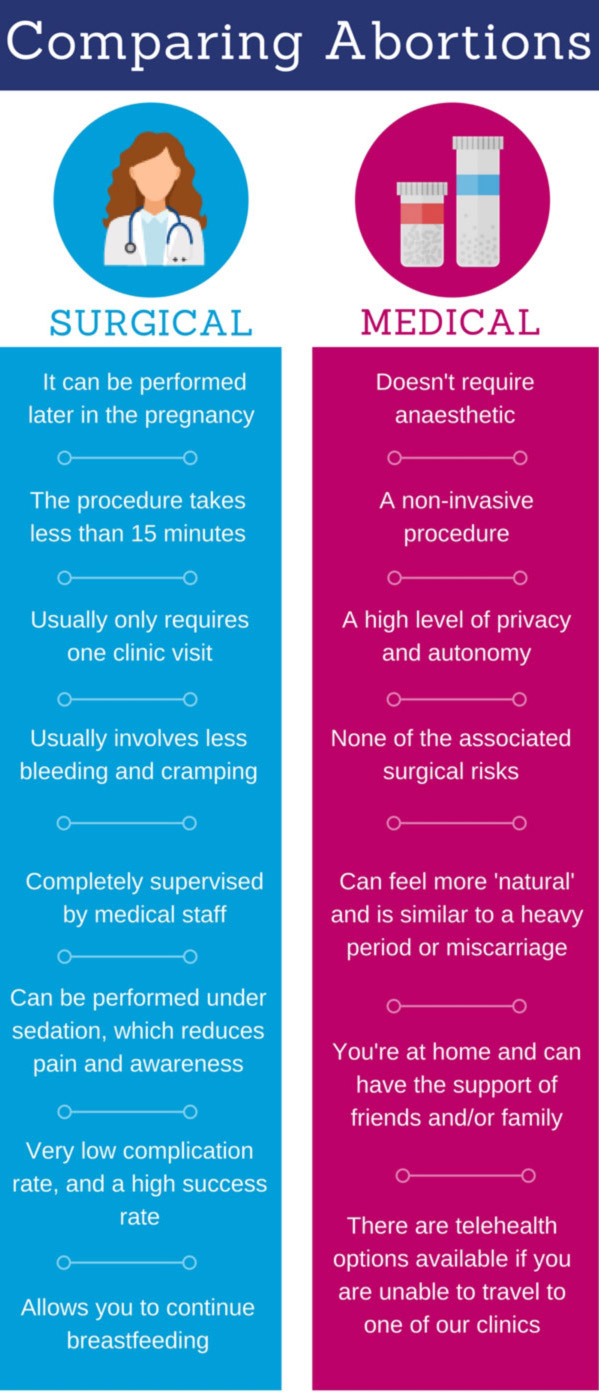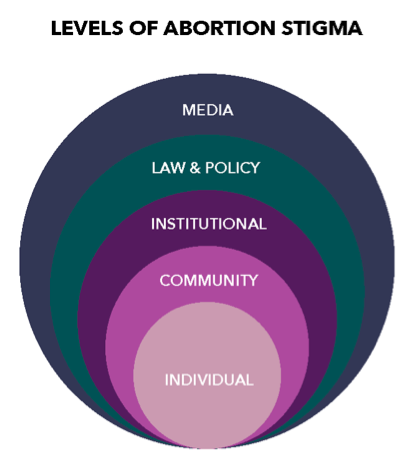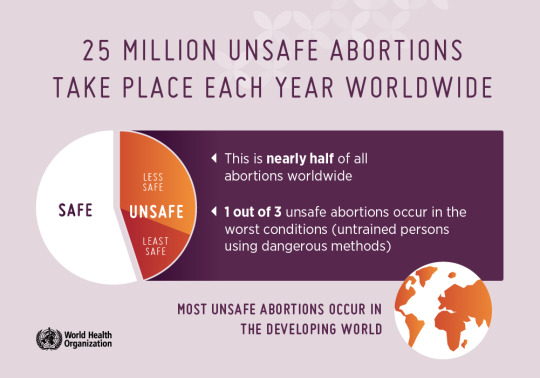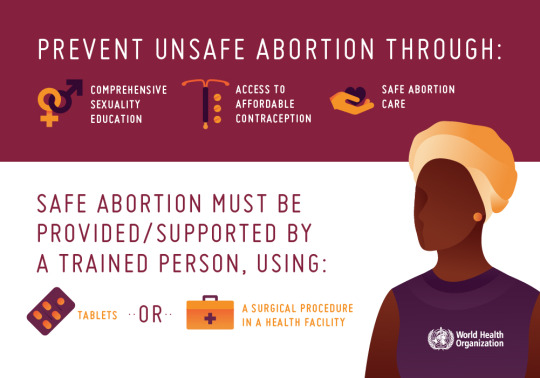Quote
Access to legal, safe and comprehensive abortion care, including post-abortion care, is essential for the attainment of the highest possible level of sexual and reproductive health.
https://www.who.int/health-topics/abortion#tab=tab_1
0 notes
Text
Overview

In 2020, the debate surrounding abortion often boils down to two sides. Those two sides are commonly known as pro-choice and pro-life. The pro-life side typically argues that the “baby's life matters too.” Although, they generally fail to recognize that abortion is going happen whether it’s legal or not. Instead of criminalizing women for choosing what’s best for their body and circumstances, it’s important to offer them healthcare facilities that will provide them with a proper medical procedure. Back in 1967, the World Health Organization (WHO), declared unsafe abortions as one of the main public health problems (Finer et al, 2013). Without access to safe and legal abortions, women will find other ways to have a self-induced abortion. These self-induced abortions have the potential to cause a multitude of health problems and even potentially death.They range from taking pills, abusing ones self, hangers, etc. There’s no reason women should still have to perform these actions when modern medicine and technology exist. The stigma and negative connotation surrounding abortion will continue to limit women’s reproductive’s rights all over the world. I've provided an abundance of information below that explains the progression and regression countries have, in terms of protecting the livelihood of women.
Medical VS. Surgical Abortions: BOTH SAFE!
Medical abortions: an abortion pill that can be taken in the early weeks of pregnancy. It takes 24 hours to complete, but requires no surgery.
Surgical abortions: these procedures only take about 5-10 minutes at a clinic/facility.

“Both in-clinic and medication abortions are very safe. In fact, abortion is one of the safest medical procedures out there.” - Planned Parenthood
0 notes
Text
Timeline on Abortion Laws
Finer, L., & Fine, J.B.2013.Abortion Law Around the World: Progress and Pushback. American Journal of Public Health (1971), 103(4), 585–589.
Instead of just summarizing text around the years in which abortion was banned and legalized, I wanted to create a broad timeline that could help you envision what most countries were doing during these time periods. I included some specifics, like Roe VS. Wade, due to it being an extremely pivotal moment in our U.S. history, considering abortion was illegal in the majority of the United States before this case.
Post WW2 (1939-1945): Majority of countries criminalized abortion all together.
1950s: Eastern & Central European countries began easing up on their abortion laws.
Roe VS. Wade (1973): The U.S. Supreme Court legalized abortion in all 50 states.
1950s-1985: The majority of industrialized countries made abortion legal and safe.
1994: During the International Conference on Population & Development Programme of Action, 179 countries pledged to make abortion safe.
Post 1994: Following this conference, 25 more countries made abortion legal, while some others became even stricter on their abortion laws.
21st Century: Some countries finally progressed in their abortion stance, while others have backtracked.
For further understanding of abortion before the 1900s in the U.S. specifically, I encourage to watch the short clip below!
https://www.cnn.com/2020/01/02/politics/congress-asks-supreme-court-to-reconsider-abortion-case/index.html
0 notes
Link
*click the link to get to the map!*
The Center for Reproductive Rights is an organization that continues to fight for women’s rights all over the world. Their website contains a plethora of information that could be of beneficial to you or your own research. I encourage you to look at the map they provide, since it gives a detailed analysis of current abortion laws in every country.
0 notes
Text
Statistics
67 countries allow abortion upon request. - 590 million women of reproductive age have access to safe and legal abortion. Many of countries have gestational limits to them. The most common gestational limit is 12 weeks.
14 countries only allow abortion due to broad social & economic reasonings. - 380 million women of reproductive age are allowed abortions based off of their environment and finances.
56 countries only allow abortion in cases where it will maintain the woman’s mental health. - 240 million women of reproductive age are allowed abortions to save their mental wellbeing.
39 countries only allow abortion in order to save the woman’s life. - 360 million women of reproductive age are only allowed abortions if it put’s their own life in danger.
26 countries don’t allow abortion AT ALL. - 90 million women of reproductive live under this extremely strict policy.
Link: https://reproductiverights.org/worldabortionlaws
DEFINITIONS:
Reproductive Age: 15 years old to 49 years old.
Gestational: The duration of time the unborn child has been in the womb.
0 notes
Text
Barriers in a “Women-Friendly” Country
“In Sweden, it seems to have been important to ensure that diverse religious communities are represented in healthcare institutions, although little attention has been directed at the political or religious ideas they uphold when patients seek spiritual advice and sympathy.”
- Arousell, Carlbom, Johnsdotter, & Essen.

Sweden, a country known to be extremely “Women-Friendly” still has certain downfalls in its public healthcare system. Throughout my research on this topic, I learned that Sweden has religious counselors in all of its public healthcare facilities. They offer counseling services to patients of many different religious denominations. Though, it is important to note that women are NOT required to have appointments with these counselors, but if they do, the influence they may have on the patients is rather questionable.
In a 2019 study, researchers asked religious counselors of Catholic, Muslim, Buddhist, and Protestant faith, how’d they advise a woman who is seeking an abortion. They approached this study by using interviews, which is a qualitative method.They found that counselors of the Catholic and Buddhist faith, would advise women not to have an abortion. Their argument fell along the lines of a typical pro-life stance, and said that the fetus’s life mattered more than the woman’s current circumstances. The Muslim counselor said that he’d advise the woman to only get an abortion if it was going to put her own life at risk. The Protestant counselor, which upholds the common religion of Sweden, said that he’d advise the woman to do what she wanted, and not what may be “religiously correct” (Arousall et al, 2019).
“It is clear that there is a contradiction between the perspectives on abortion: those present in the liberal Swedish discourse and legislation on the one hand, and in many of the religious counsellors’ points of view on the other.”
-Arousell, Carlbom, Johnsdotter, & Essen.
To uphold the standards that Sweden has set into place, I believe that all healthcare workers, even the religious counselors, should respect the choice women make. Religious concerns are one of the highest reasonings to be against abortion, but this is a barrier that many, if not all, countries need to cross in order to truly have the best interest of women at heart (Finer et al, 2013). With all that being said, Sweden is still a country that has made tremendous progress in creating equality between women and men. While researching, I found this website that provides a timeline showing the progress the country has made to protect women.
Link: https://sweden.se/society/gender-equality-in-sweden/
0 notes
Quote
"The roots of abortion stigma, including narrow gender roles, intent to control female sexuality and compulsory mother-hood are social constructs."
Reproductive Health Matters Vol. 17. No. 34
0 notes
Text
Stigma Around Abortion

Hanschmidt, F., Linde, K., Hilbert, A., Riedel‐ Heller, S.G. and Kersting, A. 2016. Abortion Stigma: A Systematic Review. Perspect Sex Repro H, 48: 169-177.
Service delivery. 2009. Reproductive Health Matters, 17(34), 212-215.
Following the conversation on countries that allow abortions, these countries still have implemented stigmas amongst them. Even though the U.S. has legalized abortion, this country has gestational limits, waiting periods for abortions, and required ultrasound appointments in certain states (Hanschmidt et al, 2016). All of these factors contribute to women having a rather negative abortion experience, since this leads individuals to become more wary of the criticism they’ll face from others.
A 2016 study, found that abortion patients experienced criticism from friends, family, partners, religious and medical institutions, as well as from their selves (Berglas et al, 2016). Although, they concluded that women were less-likely to be stigmatized against in cities that were more deemed more progressive. This is helpful for individuals who live in progressive cities, but doesn’t help women who are surrounded by people who are going to critic them for doing what's best for their well-being. Though it will be hard to completely remove the stigma around abortion, it may be possible to reduce it with helpful interventions and furthering the education amongst the medical procedure (“Service Delivery,” 2009).
0 notes
Text
Not all European Countries Have Access to Safe Abortions

Arousell, J., Essén, B., Carlbom, A., & Johnsdotter, S. 2019. Does Religious Counselling on Abortion Comply with Sweden’s ‘Women-Friendly’ Abortion Policies? A Qualitative Exploration Among Religious Counsellors. Sexuality and Culture, 23(4), 1230–1249.
Hussein, J., Cottingham, J., Nowicka, W., & Kismodi, E. 2018. Abortion in Poland: Politics, progression and regression. Reproductive Health Matters, 26(52), 11-14.
Service delivery. 2009. Reproductive Health Matters, 17(34), 212-215.
Szelewa, D. 2016. Killing ‘Unborn Children’? The Catholic Church and Abortion Law in Poland Since 1989. Social & Legal Studies, 25(6), 741–764.
This past October, Poland further restricted their abortion laws and made it completely illegal to get an abortion. This is interesting, because Poland was once one of the only countries that had legalized abortion in Europe (Hussein et al, 2018). Throughout time, Poland has continued to get stricter and stricter, especially since the Catholic Church has a heavy impact on the countries policies and decision making.
“the Church has taken the position that abortion is equal to murder” - Dorota Szelewa
This is a prime example of how countries can make progressive laws that protect women, then reverse those laws years later due to a shift in power. Prior to the 1990s, Poland was a communist country that offered abortion for women under certain circumstances of rape, incest, or health problems. Once the communist party fell out of power, new political leaders pushed for the reversal of these abortion laws. With the fall of the communist party, the Catholic Church became a trustworthy place for many people. Szelewa stated that “Church buildings were safe havens, where public gatherings could take place, and were also used by the opposition leaders who often had strong ties to the priests.” Activists and supporters of progressive abortion laws have been heavily protesting the bills that have been made by the new Polish government, but their voices aren’t being listened to or heard. Hussein, Cottingham, Norwicka, and Kismodi stated that, “Slightly over one thousand abortions were legally performed in Poland in 2016. It is believed that there are many more illegal abortions, with estimates lying between 50,000 and 200,000.” These numbers further indicate that abortion is going to happen whether it’s legal or not, and the importance of providing safe abortion services. Although, these 2016 estimates, did not stop the country’s political leaders from continuing through with the decision to make abortion illegal in all circumstances. This shows the lack of concern they have for what women are asking for, and instead have their own political agenda. The brief YouTube video below shows the different stances between Polish women and the Polish government. In my personal opinion, abortion shouldn’t be deemed as “political” but these are the current circumstances women all over the world are dealing with. Not only are abortions illegal in Poland, the amount of sex education in this country is extremely low. Service Delivery states that “Poland does not have a nation- wide sex education programme and access to sex education and other reproductive health services is often obstructed under pressure of Catholic morality.” The beliefs held by a religious institution should not be able to dictate the lives of millions of individuals, but this is the reality in this country. Change needs to be made in order to protect the lives of women who live in Poland.
0 notes
Text
Abortion in Developing Countries
“45% of all abortions are unsafe. Almost all of these unsafe abortions occur in developing countries.”

- https://www.who.int/health-topics/abortion#tab=tab_2
The World Health Organization website lists some very worrisome statistics in regards to unsafe abortions. To summarize these statistics, 1/3 of all unsafe abortions take place by untrained “professionals,” not even the women themselves. In places like Africa and Latin America, 75% of all abortions are unsafe. These numbers are so high due to the lack of training in countries were abortion restrictions have only been lifted in more recent years, and because of the strict restrictions that are still taking place. If we examine the world map provided by the Center for Reproductive Rights, we can see that countries in South America and Africa are not liberal at all in terms of abortion. Only a handful of countries between the two continents offer abortion upon request. Those countries include: South Africa, Uruguay, Guyana, Mozambique, French Guinea, Guinea-Bissau, and Tunisia, offer those services. As far as the rest of the countries, there’s restrictions put into place and lives at risk.
Ziraba, A., Kasiira, I., Chimaraoke, L., Brooke, A., Gebreselassie, H., Mutua, M., Mohamed, S.F., Egesa, C., & Kimani-Murage, E.W. 2015. Unsafe abortion in Kenya: a cross-sectional study of abortion complication severity and associated factors. BMC Pregnancy and Childbirth, 15(1), 34–34.
Kenya, a country that once banned abortions entirely, has since changed their stance on the matter. Following their new constitution, as of 2015, women are allowed abortions in Kenya under *certain circumstances.* They’re only allowed abortions if they’re facing any physical or mental health complications. Though, since abortion was banned for so long, the healthcare workers are not trained enough to provide safe abortions to everyone (Ziraba et al, 2015).
In a 2015 study, researchers were determined to figure out how many women face complications after their facility administered abortion. They used a 30-day survey to monitor any complications these patients were facing. The researchers found that 77% of women who had an abortion in any healthcare facility in Kenya, suffered from moderate to severe complications. The severest complication patients suffered from was death due to the procedure. The facilities in Kenya are based off of levels, meaning that some have more experience, expertise, and training, than others. The lower-level facility patients suffered from more complications than the high-level facilities. Which is most likely why low-income individuals suffered more than anyone else examined in the study (Ziraba et al, 2015). This information shows how badly ALL facilities need more training in developing countries, especially since developing countries suffer from the highest mortality rate of abortion.
COMPLICATIONS MANY WOMEN EXPERIENCE:
Infections
Uterine Perforation (a hole in the uterus)
Incomplete abortions
Hemorrhage (excessive bleeding)
Damage to the genitalia & internal organs
Death
Link: https://www.who.int/news-room/fact-sheets/detail/preventing-unsafe-abortion
SOLUTIONS:

Le Grand, A. 1992. The abortion pill: A solution for unsafe abortions in developing countries? Social Science & Medicine (1982), 35(6), 767–776.
Shah, I.H., & Weinberger, M. B. 2012. Expanding access to medical abortion: Perspectives of women and providers in developing countries. International Journal of Gynecology and Obstetrics, 118, S1–S3.
As mentioned in the overview, medical abortion, also known as the “abortion pill” has been proven to be a safe method for abortion. In the 1990s, this type of method was only available in more developed countries. Those countries included the Soviet Union, United States, France, Sweden, China, Cuba, Hong Kong,etc...(Grand, 1992). More recent research has shown that undeveloped countries are gaining more access to medical abortions, but typically lack the proper training to ensure the safety of the medication (Shah & Weinberger, 2012). If undeveloped countries became more informed with the guidelines to ensure medical abortions be performed safely at home, it could help reduce the likelihood of women suffering from complications. It could also be a safer solution to women who live in undeveloped countries with extremely strict abortion laws (Shah et al, 2012).
“If the abortion pill is to be offered to developing countries, more studies should be conducted to determine what is the best form of administration, how to ensure adequate information on the correct supply of the drug, how to train health workers in the safe and effective use of the abortion pill, the possibility of involving and training traditional birth attendants and traditional practitioners in the use of the abortion pill, and how to develop educational materials for women which takes into account their local perceptions on pregnancy and abortion.”
-Amanda Le Grand
0 notes
Text
Conclusions
The common theme I found throughout all of this research is that there’s still so much more progress to be made. Although, I think it’s important to acknowledge all the obstacles women throughout history have overcome to get to where we are today. With all of the studies and evidence that have been provided, it’s extremely important that safe abortions remain legal and become legal in countries where it’s not already. Without it, the rise of maternal deaths will continue to increase all over the world, because as previously mentioned, abortions will happen whether they’re legalized or not.
Without a decline in the stigma attached to abortion, women will continue to feel shame and pity regarding their decision to have this medical procedure. Many women won’t even tell the people they are closest to, because the fear of judgment around such a controversial topic is worrisome. I personally don’t believe abortion should be seen as “controversial,” but it’s clear that it’s a very heated topic that has many different opinions surrounding it. The opinions often stem from believing that abortion is murder, religious reasonings, believing it will decline a woman’s mental health, and many more. Throughout all of these opinions, factual information shows that this option is best for some women due to their current life circumstances. Those circumstances vary from person to person, but typically are due to low-income, not wanting to start a family, rape, lack of available contraceptions and sex education. Evidence also shows that safe abortions, provided to women by properly trained providers, won’t cause any harm to the woman. Providing safe methods of abortion is essential and necessary, because women are allowed to have a choice in a matter pertaining to their body and livelihood. I believe that all of the information i’ve provided, shows the importance of getting abortion out of political & controversial topics, and switching it a matter of healthcare.
Although, I fear that this won’t happen anytime soon in many places like; Poland, Iraq, Nicaragua, Condo, and Egypt. *these are all countries that have banned abortion all together* In many other places, abortion will continue be controversial and political, since many people are unaware of the importance of safe and legal abortion. This is another reason proper sex education and awareness to the conditions other people are going through, are extremely important as well.
Even we if look at the United States alone, we can see how divided this country is on abortion. This also continues on to the conversation around progression and regression, because of what’s currently happening in our own government. On October 26, 2020, Amy Coney Barrett got confirmed into the supreme court. This brought up a tremendous amount of worry to the pro-choice movement, since Barrett is known to be extremely pro-life. Barrett filled the seat of our late Justice Ruth Badar Ginsburg. RBG was a known pioneer in the women’s right movement and spent years of her life fighting for gender equality. Ginsburg being replaced by someone who is not progressive, is a very scary thought for many women in the United States, because once again, this is the potential to regress away from vital reproductive services to women.

0 notes
Text
References
Arousell, J., Essén, B., Carlbom, A., & Johnsdotter, S. 2019. Does Religious Counselling on Abortion Comply with Sweden’s ‘Women-Friendly’ Abortion Policies? A Qualitative Exploration Among Religious Counsellors. Sexuality and Culture, 23(4), 1230–1249.
Finer, L., & Fine, J.B. 2013. Abortion Law Around the World: Progress and Pushback. American Journal of Public Health (1971), 103(4), 585–589.
Hanschmidt, F., Linde, K., Hilbert, A., Riedel‐ Heller, S.G. and Kersting, A. 2016. Abortion Stigma: A Systematic Review. Perspect Sex Repro H, 48: 169-177.
Hussein, J., Cottingham, J., Nowicka, W., & Kismodi, E. 2018. Abortion in Poland: Politics, progression and regression. Reproductive Health Matters, 26(52), 11-14.
Le Grand, A.1992. The abortion pill: A solution for unsafe abortions in developing countries? Social Science & Medicine (1982), 35(6), 767–776.
Service delivery. 2009. Reproductive Health Matters, 17(34), 212-215.
Shah, I.H., & Weinberger, M. B. 2012. Expanding access to medical abortion: Perspectives of women and providers in developing countries. International Journal of Gynecology and Obstetrics, 118, S1–S3.
Szelewa, D. 2016. Killing ‘Unborn Children’? The Catholic Church and Abortion Law in Poland Since 1989. Social & Legal Studies, 25(6), 741–764.
Ziraba, A., Kasiira, I., Chimaraoke, L., Brooke, A., Gebreselassie, H., Mutua, M., Mohamed, S.F., Egesa, C., & Kimani-Murage, E.W. 2015. Unsafe abortion in Kenya: a cross-sectional study of abortion complication severity and associated factors. BMC Pregnancy and Childbirth, 15(1), 34–34.
1 note
·
View note